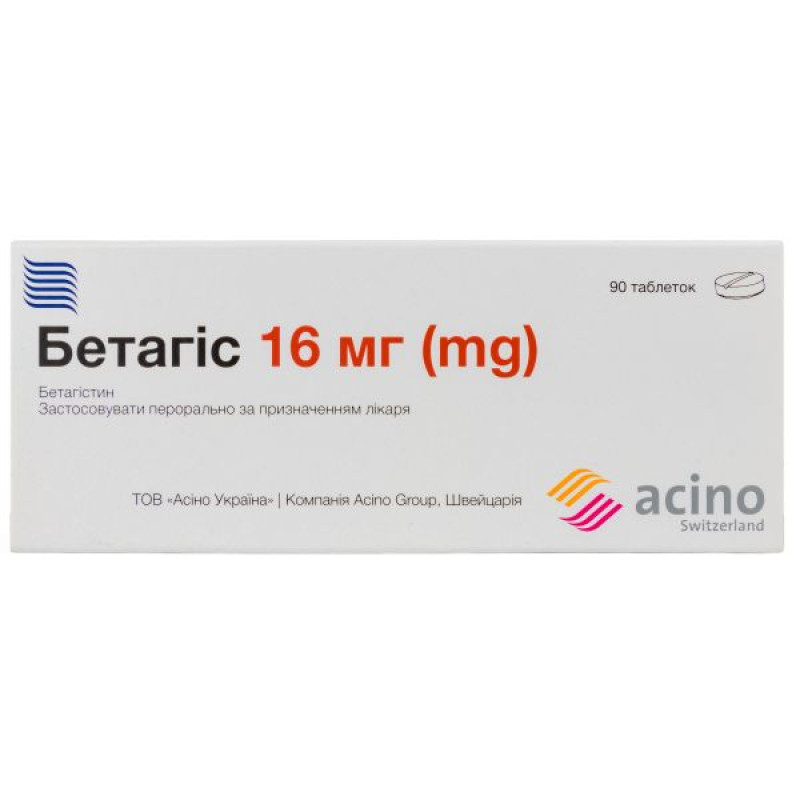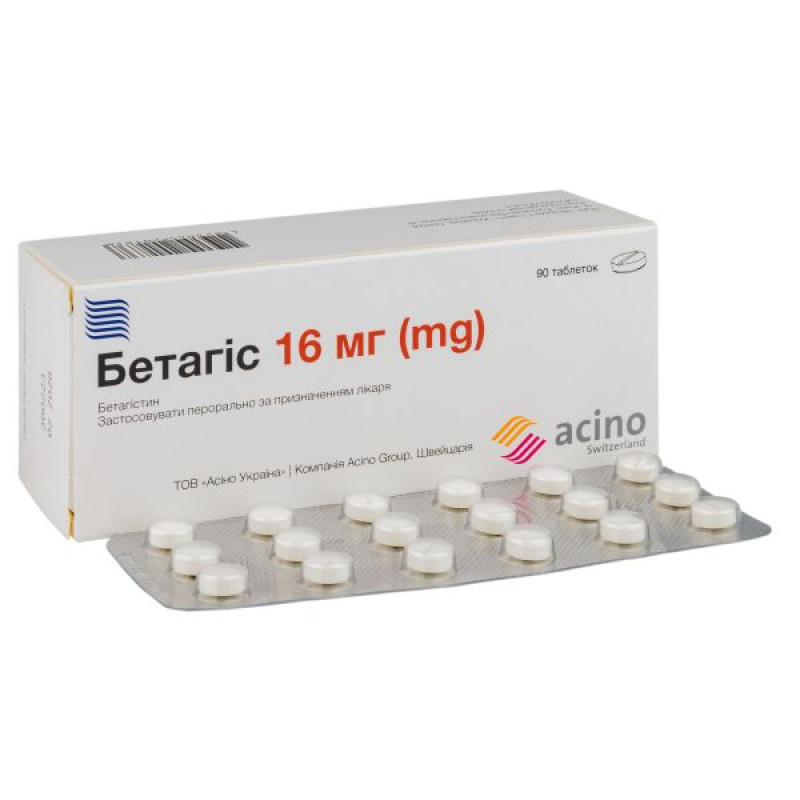Betagis tablets 16 mg No. 90

Instructions Betagis tablets 16 mg No. 90
Composition
active ingredient: betahistine dihydrochloride;
1 tablet contains: betahistine dihydrochloride 16 mg;
Excipients: microcrystalline cellulose; mannitol (E 421); citric acid monohydrate; colloidal anhydrous silicon dioxide; potato starch; talc.
Dosage form
Pills.
Main physicochemical properties: round tablets, with a biconvex surface, with a score, white or almost white in color.
Pharmacotherapeutic group
Treatments for vestibular disorders.
ATX code N07C A01.
Pharmacological properties
Pharmacodynamics
The mechanism of action of betahistine is only partially understood. There are several plausible hypotheses that have been supported by animal and human studies.
The effect of betahistine on the histaminergic system.
Betahistine has been shown to have partial agonist activity at H1 receptors and antagonist activity at histamine H3 receptors in nervous tissue, with little activity at histamine H2 receptors. Betahistine increases histamine metabolism and release by blocking presynaptic H3 receptors and inducing a process of downregulation of the corresponding H3 receptors.
Betahistine can increase blood flow in the cochlear area, as well as throughout the brain.
It is known that pharmacological studies in animals have shown an improvement in blood flow in the stria vascularis of the inner ear, possibly by relaxing precapillary sphincters in the inner ear microcirculation system. Betahistine has also been shown to increase cerebral blood flow in humans.
Betahistine promotes vestibular compensation.
Betahistine accelerates the recovery of vestibular function after unilateral neurectomy in animals by stimulating and promoting the process of central vestibular compensation. This effect is characterized by increased regulation of histamine metabolism and release and is realized as a result of H3-receptor antagonism. In humans, treatment with betahistine also reduced the time to recovery of vestibular function after neurectomy.
Betahistine alters the activity of neurons in the vestibular nuclei.
It was also found that betahistine has a dose-dependent inhibitory effect on the generation of spike potentials in neurons of the lateral and medial vestibular nuclei.
The pharmacodynamic properties of betahistine, as shown in animals, may provide a positive therapeutic effect of the drug in the vestibular system.
The effectiveness of betahistine has been shown in studies in patients with vestibular vertigo and Ménière's disease, as demonstrated by a reduction in the severity and frequency of vertigo attacks.
Pharmacokinetics
Absorption. When taken orally, betahistine is rapidly absorbed from the digestive tract. The bioavailability of the drug reaches 100%. After absorption, betahistine is rapidly and almost completely metabolized to form the metabolite 2-pyridylacetic acid (which has no pharmacological activity). The concentration level of betahistine in blood plasma is very low, so all pharmacokinetic analyses are carried out by measuring the concentration of the metabolite 2-pyridylacetic acid in blood plasma and urine.
After oral administration of betahistine, the maximum concentration of 2-pyridylacetic acid in blood plasma (and urine) is determined 1 hour after administration and decreases with a half-life of about 3-4 hours.
When taken with food, the maximum concentration (Cmax) of the drug is lower than when taken on an empty stomach. At the same time, the complete absorption of betahistine is identical in both cases, which indicates that food intake only slows down the absorption process of the drug.
Distribution: The percentage of betahistine bound to plasma proteins is less than 5%.
Excretion. 2-pyridylacetic acid is rapidly excreted from the body in the urine. When taking the drug in a dosage of 8-48 mg, about 85% of the initial dose is found in the urine. The excretion of betahistine by the kidneys or with feces is insignificant.
Linearity. The recovery rate remains constant over the oral administration of 8-48 mg of the drug, indicating linearity of the pharmacokinetics of betahistine and suggesting that the metabolic pathway involved is non-saturable.
Indication
Meniere's disease and syndrome, which are characterized by three main symptoms:
dizziness, sometimes accompanied by nausea and vomiting; hearing loss (hearing loss); tinnitus.
Symptomatic treatment of vestibular vertigo of various origins.
Contraindication
Increased individual sensitivity to betahistine or to any of the components of the drug.
Pheochromocytoma.
Interaction with other medicinal products and other types of interactions
In vitro data indicate that betahistine metabolism is inhibited by drugs that inhibit monoamine oxidase (MAO) activity, including MAO subtype B (e.g. selegiline). Caution is recommended when betahistine is used concomitantly with MAO inhibitors (including selective MAO subtype B).
Since betahistine is a histamine analogue, the interaction of betahistine with antihistamines could theoretically affect the effectiveness of one of these drugs.
Application features
During treatment with the drug, it is necessary to carefully monitor the condition of patients with bronchial asthma and/or a history of gastric and duodenal ulcers.
Ability to influence reaction speed when driving vehicles or other mechanisms
Betahistine is indicated for the treatment of Ménière's syndrome, characterized by a triad of the main symptoms: dizziness, hearing loss, tinnitus, as well as for the symptomatic treatment of vestibular vertigo. Both conditions may adversely affect the ability to drive and use machines. According to clinical studies, betahistine had no or negligible influence on the patient's ability to perform activities requiring increased attention and speed of psychomotor reactions.
Use during pregnancy or breastfeeding
Pregnancy. There are no adequate data from the use of betahistine in pregnant women. It is known that the results of studies of betahistine in animals are insufficient to assess the effects on the course of pregnancy, embryonal/fetal development, childbirth and postnatal development. The potential risk for humans is unknown. Betahistine should not be used during pregnancy unless clearly necessary.
Breastfeeding. It is not known whether betahistine is excreted in human milk. It is known that animal studies on the excretion of betahistine in milk have not been conducted. The benefit of the drug for the mother should be weighed against the benefits of breastfeeding and the potential risk to the child.
Method of administration and doses
Betagis tablets should be taken orally during or after meals. The dose of the drug and the duration of the course of treatment are determined by the doctor individually for each patient, depending on the indications and severity of the disease.
Adults are usually prescribed 24 mg to 48 mg of betahistine per day (½-1 tablet 3 times a day).
Improvement is noted after 2-3 weeks. The best results are achieved with a course of treatment with Betahis for several months. Existing data indicate that the appointment of the drug at the beginning of the disease prevents its progression and/or hearing loss in the later stages.
Elderly patients
Although currently there are limited data from studies in this patient group, extensive experience with betahistine suggests that dose adjustment is not necessary for this patient population.
Renal/hepatic failure
No special clinical trials have been conducted in this group of patients, but based on experience with betahistine, dose adjustment is not required.
Children
Due to insufficient data on the safety and efficacy of betahistine in pediatric practice, it is not recommended to prescribe the drug to children.
Overdose
Several cases of betahistine overdose have been described, with the occurrence of moderate symptoms of nausea, vomiting, epigastric pain, headache, drowsiness after taking the drug in a dose of up to 640 mg. Serious complications - convulsions, cardiopulmonary disorders - are possible with intentional administration of increased doses of betahistine, especially in combination with an overdose of other drugs.
Treatment: Specific antidotes are unknown. Treatment is symptomatic and should include standard supportive measures.
Adverse reactions
Adverse reactions are classified according to the frequency of occurrence into the following categories:
very common (> 1/10), common (> 1/100 and < 1/10), uncommon (> 1/1000 and < 1/100), rare (> 1/10000 and < 1/1000), very rare (< 1/10000), unknown (frequency not estimated from the data).
From the immune system.
Hypersensitivity reactions (including anaphylaxis).
From the gastrointestinal tract.
Common: nausea and dyspepsia.
In some cases, there may be complaints of minor stomach upset (vomiting, discomfort, abdominal pain due to bloating and flatulence), more often in patients with chronic diseases of the digestive tract. These side effects usually disappear when the drug is taken with food or after reducing the dose.
From the nervous system.
Common: headache.
On the skin and subcutaneous tissue.
Hypersensitivity reactions of the skin and subcutaneous fat, including angioedema, rash, pruritus and urticaria, have been observed.
Expiration date
3 years.
Storage conditions
Store out of the reach of children, in the original packaging at a temperature not exceeding 25 ºС.
Packaging
18 tablets in a blister; 5 blisters in a cardboard pack.
Vacation category
According to the recipe.
Producer
Pharma Start LLC, Ukraine.
Location of the manufacturer and its business address
Ukraine, 03124, Kyiv, Vaclav Havel Boulevard, 8.
There are no reviews for this product.
There are no reviews for this product, be the first to leave your review.
No questions about this product, be the first and ask your question.


















